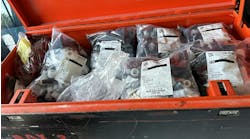Latest from Plumbing
Sponsored
We need to be united in the common goal of combating complacency regarding potable water pollution. Infants absorb lead at up to 10 times the rate as adults do. The home I grew up in had acidic water and I remember following the plumber on numerous occasions as he went about repairing the pinhole leaks caused by the aggressive water.
Lead poisoning contributes to learning disabilities and can cause anemia and hyperactivity.
I am dyslexic, took pills for anemia as a child and was extremely hyperactive to boot. The anemia was treated and the hyperactivity eventually settled down, sort of. The dyslexia doesn’t go away. I was fortunate, however, to have it diagnosed early enough to attend The Gow School during my last two years of high school. Although dyslexia cannot be cured, we were taught to recognize and overcome the problems associated with writing and reading. I have also discovered that a large number of mechanical contractors are dyslexic.
The headline for this article is an example of how dyslexia plays tricks on our eyes. When I read that, it looks like “Plumbers untie.”
At the beginning of last month’s article, we looked at the effects of lead poisoning. The maximum contaminant level of lead in drinking water as established by the epa is 15 parts per billion. One part per billion is the equivalent of one minute in 2,000 years. The epa has established this as an “action level” for municipal water systems. If, on the other hand, this happens to be a private well-water system, the responsibility reverts solely to the owner.
Let’s get back to those upscale homes built adjacent to that old landfill that I brought up in the April column. By the time the developments (three of them ringed the edges of this area) were constructed and occupied, everyone overlooked the fact that the mountaintop had once been an open dump, long since covered over and forgotten.
Within the first few years, the residents discovered their water was polluted. So polluted, in fact, that it was declared unsafe for consumption. Bottled water was brought in for the homeowners and, within months, city water mains were constructed to provide a safe and reliable source of potable water.
Pollution in underground aquifers moves very slowly. It’s extremely difficult, if not impossible, to restore polluted groundwater to potable levels. Primary treatment involves using stripping towers to remove volatile organic compounds and constant pumping to spill on grade. The intended result is for the flow of sub-surface water to move toward the contaminated area. Unfortunately, this often comes too late for homeowners connected to the same aquifer.
We ran into one case last year where two young children had elevated blood levels of lead poisoning. At first glance, it seemed prudent to install a filtration system for their drinking water or to have them bring in bottled water for drinking, cooking and brushing teeth. It is important, however, to understand that lead poisoning can also be absorbed through the skin or lungs by way of mist. This meant that even bathing or showering the children in this water would continue to maintain elevated blood levels of lead poisoning.
In order to rule out the home’s copper plumbing (old enough to have been joined with 50/50 solder and it is also acidic), we drew a sample at a faucet and a second sample at the pump tank tee after running the water for 20 minutes.
Given that we sell treatment equipment, we typically have an independent lab perform the analysis to avoid any perceived conflict of interest. The lab test results clearly indicated a very high level of lead in the well water being delivered to the home from the aquifer and that treatment of this water was needed.
The next step is to examine the various filtration media and treatment methods available. Next, consider the various costs associated with the equipment and its operation.
Under many circumstances, such as a home on municipal service, the concerns are based more on perceptions than on actual facts regarding lead contamination. If you don’t believe that, simply visit the filtration section of the big-box diy center and watch the parade of homeowners carrying off equipment! To tell you the truth, I like checking their aisles. They spend tons of money to figure out what the public wants and then they stock the shelves to the rafters.
It’s nice to know your competition and their lack of knowledge! You know so much more than inexperienced salespeople that selling filtration equipment can be a breeze. All you need is an envelope stuffer or piece of literature for your mechanics to give the homeowner.
Some entry-level canister style filters can remove up to 98% of lead. Their drawback is the typical 600-gal. limit of treatment. Are you thinking filter maintenance contracts yet? Larger whole-house models are available too.
Reverse osmosis filters are the next level and are extremely effective at removing just about everything except the water. Expense steps up, as you would expect — you get what you pay for. Their drawback is their relatively slow processing of the water and that means a storage tank is needed with adequate draw-down capacity.
Another method used more in commercial than residential applications is distillation. This involves heating the water to steam and then running it through a condensation loop. Effective but very expensive.
Protecting the health of the nation; providing peace of mind; a much needed service and doing it profitably. It just doesn’t get any better than that.
Dave Yates
Dave Yates material in print and on Contractor’s Website is protected by Copyright 2017. Any reuse of this material (print or electronic) must first have the expressed written permission of Dave Yates and Contractor magazine.

